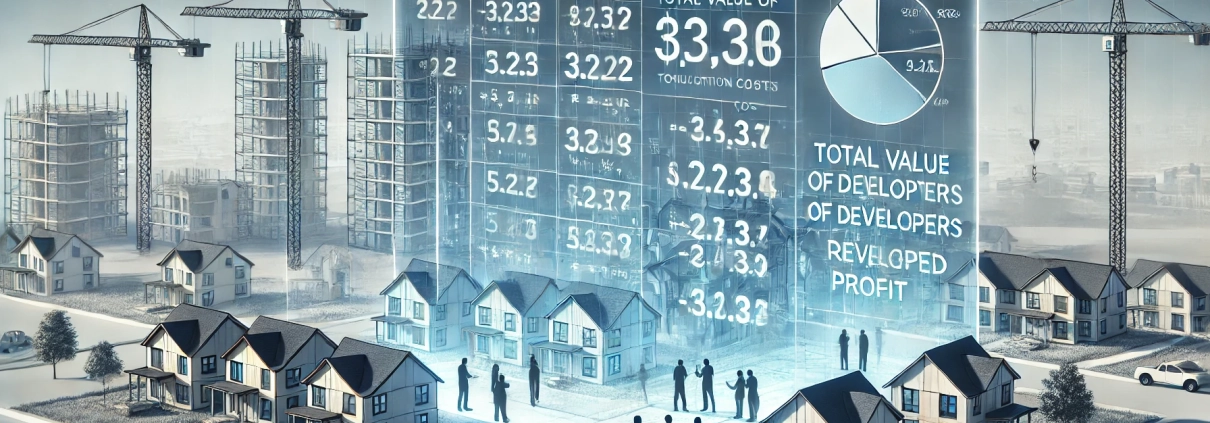Residual Land Value Analysis
Residual land value is a method for calculating the value of development land. This is done by subtracting from the total value of a development, all costs associated with the development, including profit but excluding the cost of the land. The amount left over is the residual land value, or the amount the developer is able to pay for the land given the assumed value of the development, the assumed project costs, and the developer’s desired profit.
Putting ‘Residual Land Value Analysis’ in Context
The Scenario
Lone Star Urban Developments, a real estate development firm specializing in multifamily Build-to-Rent (BTR) residential projects, is considering a new development opportunity in Kansas City, Missouri. The proposed project, known as The Shoal Creek Residences, is a 150-unit Build-to-Rent residential community featuring a mix of 2- and 3-bedroom single-family homes. The community will offer shared amenities such as a clubhouse, fitness center, and pool to attract long-term renters looking for the space of a home with the convenience of renting.
Lone Star Urban Developments is attempting to determine how much they can afford to pay for the 20-acre parcel of land where the community will be built. To do so, they will use a Residual Land Value Analysis.
Key Assumptions
To conduct the analysis, Lone Star makes the following key assumptions:
- Total Value of Completed Development (Gross Sales Value or Stabilized Value): $45,000,000
- Development Costs (Hard Costs and Soft Costs): $30,000,000
- Developer’s Required Profit (Targeted Return on Cost): 20% of Total Development Costs
The formula for Residual Land Value is:
Residual Land Value = Total Value of Development - (Development Costs + Developer's Required Profit)
Step-by-Step Calculation
1. Calculate the Developer’s Required Profit
The developer aims for a 20% profit on total development costs.
Developer's Required Profit = Development Costs x Profit Percentage Developer's Required Profit = 30,000,000 x 0.20 = 6,000,000
2. Calculate the Residual Land Value
To determine how much Lone Star can pay for the land, they subtract both the development costs and the developer’s profit from the total value of the completed development.
Residual Land Value = Total Value of Development - (Development Costs + Developer's Required Profit) Residual Land Value = 45,000,000 - (30,000,000 + 6,000,000) Residual Land Value = 45,000,000 - 36,000,000 Residual Land Value = 9,000,000
The Result
Based on the Residual Land Value Analysis, Lone Star Urban Developments can afford to pay up to $9,000,000 for the 20-acre parcel of land. If the landowner is willing to sell at or below this price, the project is feasible under Lone Star’s assumptions for costs, profit, and future value. However, if the landowner’s asking price is higher, Lone Star may need to revise its development assumptions, increase rents, reduce costs, or accept a lower profit.
Key Takeaways
- Purpose: The purpose of a Residual Land Value Analysis is to determine the maximum amount a developer can pay for land while still achieving a desired profit.
- Key Variables: Total value of the completed development, total development costs, and developer’s required profit are the three critical inputs to the calculation.
- Negotiation Tool: Armed with this analysis, Lone Star can approach the landowner with a clear rationale for their offer price, supporting their negotiation position.
- Flexibility: If Lone Star’s assumptions change, such as reduced construction costs or higher projected rents, the amount they can pay for the land will increase.
By using Residual Land Value Analysis, Lone Star Urban Developments can make an informed, data-driven offer on the Kansas City site for The Shoal Creek Residences.
Frequently Asked Questions about Residual Land Value Analysis
What is Residual Land Value?
Residual land value is a method for calculating the value of development land. It is determined by subtracting all development costs and the developer’s required profit from the total value of the completed project.
What is the formula for calculating Residual Land Value?
The formula is:
Residual Land Value = Total Value of Development – (Development Costs + Developer’s Required Profit)
How was the Residual Land Value calculated for The Shoal Creek Residences project?
For this Kansas City project, the inputs were:
Total Value of Development: $45,000,000
Development Costs: $30,000,000
Required Profit: $6,000,000 (20% of costs)
Residual Land Value = $45,000,000 – ($30,000,000 + $6,000,000) = $9,000,000
Why is Residual Land Value important to developers?
It tells a developer how much they can afford to pay for land while still achieving their desired profit, based on the expected costs and revenue from the project.
How does required profit affect the Residual Land Value?
A higher required profit lowers the Residual Land Value, since it increases the amount subtracted from the total project value. In the case study, the 20% profit margin reduced the amount available to pay for land by $6,000,000.
Can Residual Land Value change over time?
Yes. Changes in development costs, projected revenues, or profit expectations will directly impact the Residual Land Value. For example, if rents rise or construction costs drop, the amount a developer can pay for land increases.
How does Residual Land Value help in land price negotiations?
It provides a rational basis for an offer price. Developers like Lone Star Urban Developments can show sellers a data-driven explanation for why they can pay a specific amount for the land.
Click here to get this CRE Glossary in an eBook (PDF) format.

